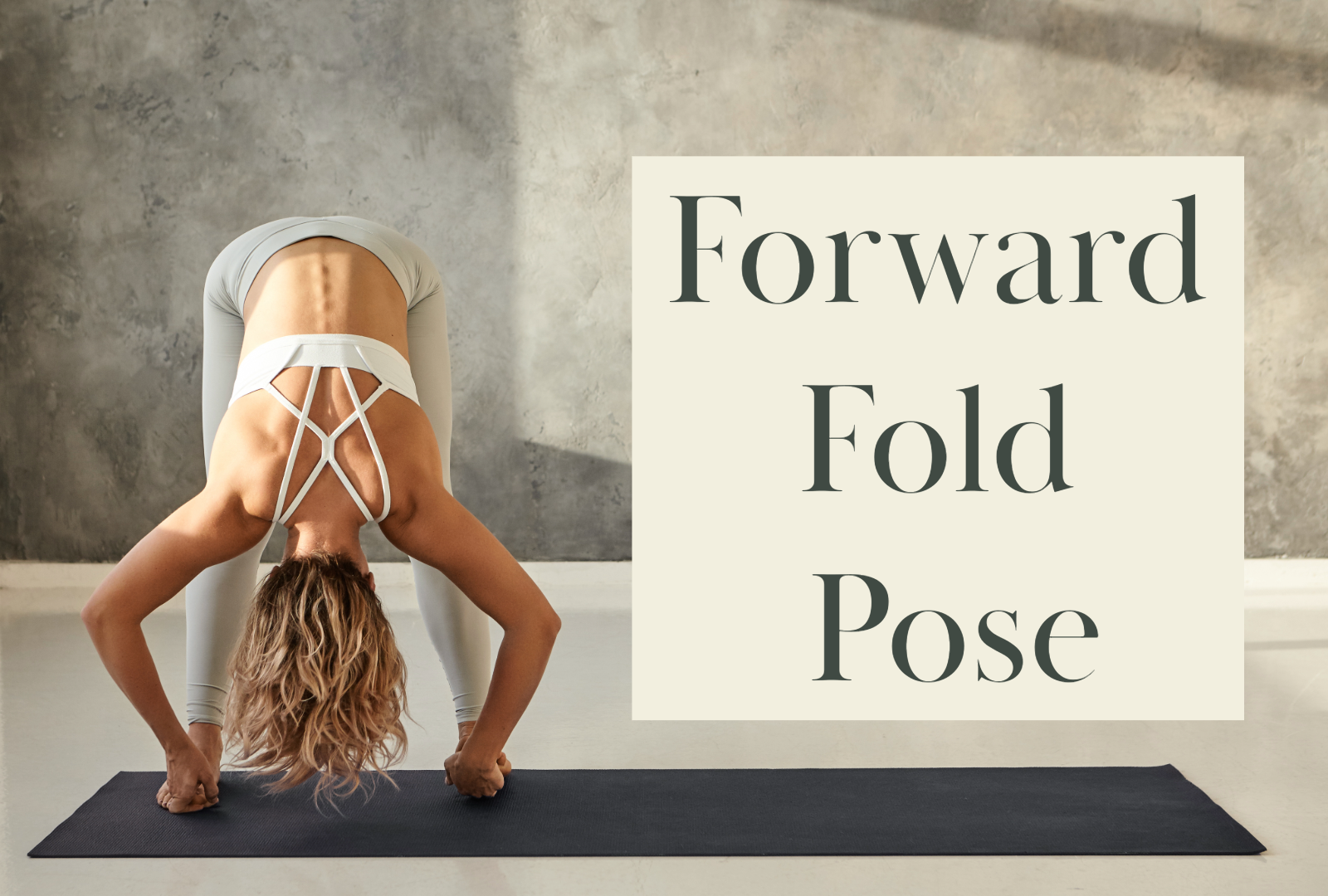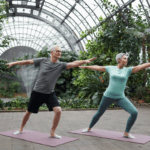Coming Soon: E-book about Kundalini Yoga - Sign up here to be among the first to get it!
Sanskrit: Uttanasana
Type: Standing Pose
Chakra Involved: Crown Chakra (Sahasrara Chakra), Solar Plexus (Manipura Chakra), Sacral Chakra (Swadisthana Chakra), Root Chakra (Muladhara Chakra)

Forward Fold (Uttanasana)
Forward Fold, or Uttanasana, is a fundamental yoga pose that stretches the hamstrings, calves, and hips, while calming the mind and relieving stress. This pose is often used as a transition in sequences like the Sun Salutation and can help prepare the body for deeper stretches. It not only improves flexibility in the back and legs but also stimulates the digestive, nervous, and endocrine systems.
Starting Position
Begin standing in Mountain Pose (Tadasana) at the top of your mat, with your feet hip-width apart and parallel, arms by your sides. Distribute your weight evenly through your feet, engage your thigh muscles, and draw your belly slightly in.
Step-by-step Instruction
- Inhale and Lengthen: Inhale deeply, lifting your arms out to the sides and overhead, palms facing each other. As you reach up, lengthen your spine and slightly arch back from the upper back to open the chest.
- Exhale and Fold: On an exhale, hinge at your hips (not the waist) to fold forward over your legs. Lead with your chest to keep the spine long. Bend your knees slightly if needed to protect your lower back.
- Release into the Pose: Bring your fingertips or palms to the floor beside your feet, to your shins, or hold onto your elbows with opposite hands for a deeper stretch. Allow your head to hang heavy, releasing tension in your neck.
- Deepen the Stretch: With each exhale, gently deepen the fold, aiming to bring your chest closer to your legs. Keep your hips over your ankles, and if your hands are on the ground, press into the floor to lift and lengthen your torso slightly with each inhale.
- Hold the Pose: Stay in this position for 30 seconds to 1 minute, breathing deeply. Focus on lengthening your spine on the inhales and deepening your fold on the exhales.
To Release the Pose
- Release Your Hands: If your hands are on the ground or holding your elbows, release them and place your palms on your hips.
- Inhale and Rise: Engage your core and, with a flat back, slowly rise to standing on an inhale, leading with your chest and head coming up last.
- Return to Mountain Pose: Stand tall in Tadasana for a few breaths, noticing the sensations in your body.
Teacher’s Tip
- Knee Bend: Encourage students with tight hamstrings or lower back issues to keep a slight bend in their knees during the fold. This modification helps protect the back and still allows for a deep stretch in the legs.
- Hip Hinge: Remind students to fold from the hips rather than rounding the lower back. This tip helps maintain spinal integrity and maximizes the stretch in the hamstrings.
- Breath and Movement: Highlight the importance of syncing breath with movement, using the exhale to deepen the fold, which can aid in releasing tension in the body.
- Neck Relaxation: Advise students to keep their neck relaxed and in line with their spine, letting the head hang to avoid strain.
Forward Fold is a versatile pose that can be adapted to suit a wide range of abilities, making it a staple in yoga practices for its numerous physical and mental benefits.
Variations of Forward Fold (Uttanasana)
Forward Fold, or Uttanasana, can be adapted in various ways to suit different levels of flexibility, focus on specific areas, or introduce new challenges. Here are some common variations along with instructions for each:
1. Halfway Lift (Ardha Uttanasana)
- Instructions: From Uttanasana, place your hands on your shins, the floor, or a block, and lift your torso halfway up, lengthening your spine. Your back should be flat, and your gaze slightly forward. This variation strengthens the back and prepares the body for deeper forward folds.
2. Wide-Legged Forward Fold (Prasarita Padottanasana)
- Instructions: Step your feet wide apart, hands on hips. Inhale to lengthen the torso, and exhale as you hinge at the hips to fold forward, placing your hands on the floor beneath your shoulders. This variation intensifies the stretch in the hamstrings and calves and can relieve tension in the back.
3. Seated Forward Fold (Paschimottanasana)
- Instructions: Sit on the floor with your legs extended in front of you. Inhale to lengthen your spine, and exhale as you hinge at the hips to fold forward over your legs, reaching for your feet or shins. This seated variation allows for a deeper stretch in the lower back and hamstrings.
4. Forward Fold with a Twist
- Instructions: From Uttanasana, place one hand on the floor (or on a block) directly beneath your face. As you inhale, lift the opposite arm towards the ceiling, twisting your torso. Keep your hips square to the front. This adds a spinal twist, which can increase flexibility and stimulate digestion.
5. Hands to Opposite Elbows
- Instructions: In your forward fold, let your torso hang over your legs and reach for your opposite elbows with your hands. This ragdoll variation allows your upper body to relax completely and can help release tension in the neck and shoulders.
6. Yogic Toe Lock (Padangusthasana)
- Instructions: Slide your hands under your feet so that your toes reach your wrists. Inhale to lengthen your spine, and exhale to fold deeper, pulling with your hands to deepen the stretch. This variation increases the stretch in the hamstrings and calves and offers a gentle massage for the wrists.
7. Chair Forward Fold
- Instructions: Perform Uttanasana with your hips hovering above a chair, hands resting on the chair’s back. This provides support for those with limited flexibility, allowing them to experience the benefits of the pose without straining.
Implementation Tips
- Warm-Up: Ensure your body is adequately warmed up, especially your hamstrings and lower back, before attempting deeper variations.
- Use Props: Props like blocks, chairs, or straps can make variations more accessible and comfortable, especially for beginners or those with limited flexibility.
- Listen to Your Body: Choose the variation that feels right for your body on any given day. Avoid pushing into pain or discomfort.
- Breath Coordination: Regardless of the variation, maintain a steady, even breath to help deepen into the pose and increase relaxation.
These variations of Forward Fold can help diversify your yoga practice, catering to different needs and goals while offering the foundational benefits of Uttanasana.
FAQs About Forward Fold Pose
The Forward Fold Pose offers numerous benefits, including:
- Stretches the Hamstrings and Calves: It deeply stretches the back of the legs, improving flexibility.
- Releases Back Tension: Helps in elongating and releasing tension from the spine.
- Stimulates Digestive Organs: The folding action can stimulate abdominal organs, aiding in digestion.
- Calms the Mind: Encourages relaxation, helping to relieve stress, anxiety, and mild depression.
- Improves Circulation: As a mild inversion, it increases blood flow to the brain, refreshing and revitalizing the mind.
In yoga, the Forward Fold is commonly referred to as Uttanasana in Sanskrit, where “Ut” means intensity, “Tan” means to stretch or extend, and “Asana” means pose.
- Start in Mountain Pose (Tadasana) with your feet hip-width apart and parallel.
- Inhale and Lengthen your torso upwards.
- Exhale and Hinge at your hips to fold forward, not from the waist. Bend your knees slightly to protect your lower back, especially if you’re a beginner or have tight hamstrings.
- Place Your Hands on the floor, your shins, or hold onto your elbows if reaching the floor is not accessible.
- Relax Your Neck and let your head hang freely to avoid tension.
- Hold the pose for a few breaths, allowing your body to stretch and relax into the pose with each exhale.
Individuals with the following conditions should exercise caution or avoid forward folds:
- Low Blood Pressure: The inversion can cause dizziness.
- Glaucoma: Inversions can increase eye pressure.
- Back Injuries: Those with herniated discs or severe lower back pain should avoid deep forward bends or practice a modified version.
- Osteoporosis: Bending forward can increase the risk of compression fractures.
Forward Folds primarily stretch the hamstrings and calves. They also target the lower back, spine, and glutes to a lesser extent, promoting flexibility and relief from tension.
Difficulty in performing a forward bend stretch can arise from:
- Tight Hamstrings: The most common reason, limiting the ability to bend forward.
- Limited Hip Flexibility: Restricts the movement needed for a deep fold.
- Weak Core Muscles: A strong core supports the spine in bending forward.
- Spinal Issues: Such as stiffness or injuries, can hinder forward bending.
Forward Folds can calm the nervous system due to:
- Activation of the Parasympathetic Nervous System: The gentle pressure on the abdomen and the inversion aspect help shift the body into a state of rest and digest.
- Stress Relief: The pose encourages relaxation and stress relief, further promoting a calm state.
- Mindfulness and Breathing: The focus on breath and inward attention during the pose can mediate the body’s stress response, promoting a sense of tranquility.
Incorporating forward folds into a yoga practice can offer a blend of physical and mental benefits, enhancing overall well-being.




